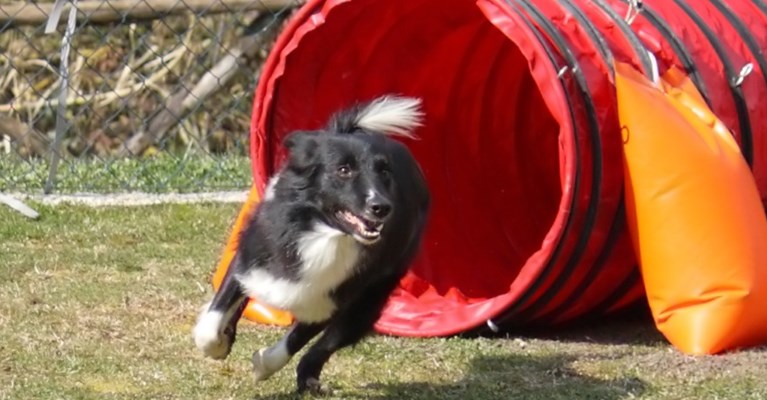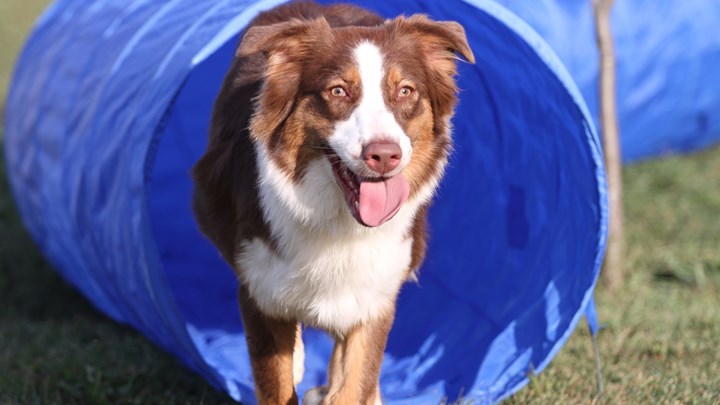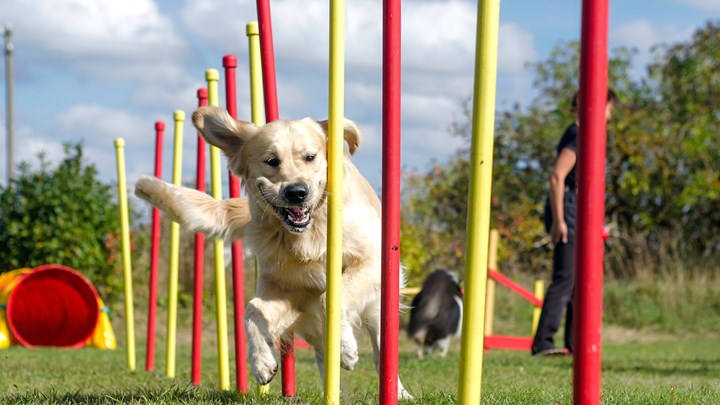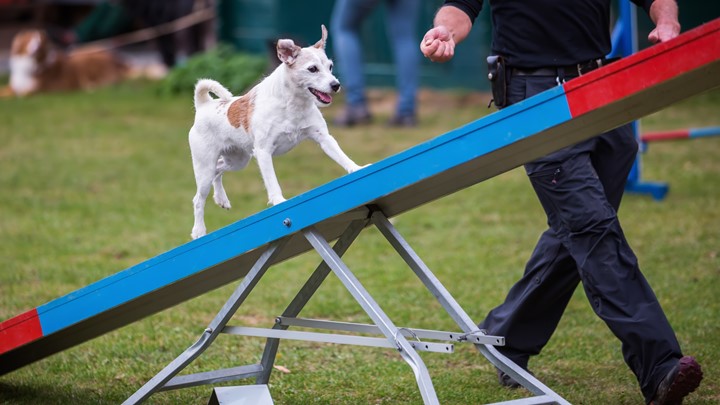Doggy Olympics: 7 Agility Exercises

If you watch Crufts, you might be left in awe, wishing that your dog could perform like those on TV. Well, now they can. Agility training isn’t just for the professional show pooches, and there are many tricks and exercises that you can teach your dog at home. From running through tunnels to jumping over hurdles, there’s so much you can do from your back garden or local park.
Teaching your four-legged friend agility tricks and exercises is a lot of fun, but it also has many health benefits, such as keeping you and your pooch in shape. As well as keeping you both healthy, it also gives you a chance to bond with your pet. Here are seven of our favourite agility exercises for you to try at home.
Easy:
Spins
An agility exercise that you don’t need any equipment at all for is the spin, and it’s surprisingly easy. The easiest way to teach them is to start off by holding a treat to the tip of their nose, and then slowly moving your hand in the direction you want them to spin. State out loud which direction you’re going, such as ‘left’ or ‘right’, and eventually your dog will start to understand the separate commands.
You can gradually move your hand higher, moving the treat further away from their face. Your pooch should automatically keep their eyes on the prize! After a lot of practice, your furry friend should be able to spin either left or right after just hearing your command.
Video sourced from American Kennel Club
Jumps
Teaching dogs to hop over hurdles is a lot of fun, as our canine companions are natural jumpers. Whether they’re saying hello, catching a ball, or smelling their tasty treats, you’ll usually catch your dog bouncing up and down when they’re excited. Jumping over hurdles is a big part of agility training, and this exercise is usually a key component to winning shows.
You can buy a range of dog hurdles online, many of which use foam bars, so if your dog is a beginner they won’t hurt themselves. Start with a low hurdle, pretty much right against the floor, and stand at the opposite side to your pooch. Call them over, and then start to introduce a command word, such as ‘jump’. Reward them with a treat, and then start to move the bar up higher, but always take into consideration how big your dog is. For example, if you’ve got a small Yorkshire Terrier, they won’t be able to jump as high as a Labrador.
Intermediate:
The Tunnel
Like humans, dogs don’t particularly like the unknown, so you need to make the tunnel trick as fun and stress-free as possible. The easiest place to start is with a straight tunnel, using positive reinforcement and treats as incentives. You can either throw treats through the tunnel whilst standing behind your pooch, or wait at the other end with a treat, in the hope that they’ll run through.
Once your pup has mastered this and can pass through it without hesitation, you can then add the curved tunnel into the mix. For a simple ‘C’ shaped curve, a smaller tunnel will be fine, but if you’re wanting to create an ‘S’ shape, you should opt for a larger tunnel. Also, take into consideration how tall your pet is, and try to accommodate the tunnel to their height. Most agility tunnels are made using non-slip material, are lightweight and come with a carry case, meaning you can practice anywhere you like.

Plank Walk
Even without any prompted practice, your four-legged friend probably has a lot of experience in plank walking. From strolling along the arm of the sofa to running across a park bench, your dog might already be great at it. If you’re wanting to train them to do the plank walk, you can practice with a park bench.
Keep your pooch on a lead and walk them back and forth across the bench, increasing the speed each time. Once they’ve improved their speed and you think they’ll be comfortable to do it on their own, remove the lead. If you want to train using a plank similar to those used in the agility shows, you can buy them online, or even build your own at home!
Video sourced from TheDogBlog
Difficult:
Weave Poles
Teaching your dog to weave around poles or cones is one of the hardest tricks within dog agility. It takes time, patience, and accuracy, because their natural reaction may be to just walk around the obstacles. Start by placing your cones or poles quite far apart from each other, and weave in and out with your pooch on a lead. Once you’re both comfortable with this, you can increase your speed and move the cones or poles closer together.
Reward your furry friend with treats when they do a full lap without you having to guide them. Eventually, you’ll be able to remove their lead, allowing them to run the weave course themselves. Another way of teaching this exercise is for you to do it first, getting them to follow you as you weave through the course. Always make sure that you leave enough space between each obstacle, so it’s safe for your dog to manoeuvre around.

Balance Board
Once your pooch has mastered the plank walk, you can move them on to the trickier balance board. Your dog will have to walk from one side to the other on something similar to a seesaw, and they won’t be familiar with the wobbly motion. Their initial reaction as they start to wobble might be to jump off the board, but if they do, just take them back to the beginning and try again safely.
You can either buy a board or make your own at home. All you’ll need for a DIY balance board, is a piece of pipe from a plumbing store, and a long plank of wood. Once you’ve got your board, start by keeping your dog on a lead and slowly walking them along the plank. As they get the hang of it, gradually increase the speed. When you feel they’re confident walking the balance board, remove their lead and see if they can do it themselves. Start off by holding a treat next to the board and walking alongside it so your dog follows. Once they start to understand the process, just wait at the end of the board with a treat, in the hope that they’ll run over towards you.

Hoop Jumps
If you’re looking to impress the neighbours with a dog agility exercise, try teaching your dog to hoop jump. If you don’t have an agility training hoop to hand, you can also practice this exercise using a hula hoop. Start by holding the hoop with one hand, at a height that’s touching the ground. Use the other hand to hold the treat, and pass it through the hoop so your dog follows. If your dog walks around it, re-position yourself so that the treat is once again the opposite side of the hoop to your pooch, and don’t reward them until they pass through the hoop successfully.
As your four-legged friend starts to understand the process, you can start to move the hula hoop higher. This will take a lot of time and practice, so be patient with your pooch. From the start, make sure you use the same command throughout, such as ‘through’ or ‘jump’. This way, they’ll start to associate a command with an action, just like they do with ‘sit’ or ‘stay’. If you have a garden with a tree, once your dog becomes more skilled at jumping, you could even hang an old bike tyre from it. Whatever object you’re using, make sure the hole is big enough for your dog to jump through.
If you’re dreaming of competing in dog agility shows, the most popular breed for these activities is the Border Collie. They’re traditionally a herding dog, meaning they’re used to spending a lot of time outdoors and good at obeying complex commands. However, most dogs can learn these agility exercises, as long as they’re hard working, patient and loyal. Whatever type of dog you have, agility training is a great way to keep your dog fit and healthy, and it’s also the perfect time for the two of you to bond. If your dog sustains any injuries whilst trying out any dog agility exercises, be sure to take them to the vet as soon as possible. Always make sure you’ve got pet insurance too, in case the unfortunate does occur. Here at Asda Money we have a range of pet insurance cover types available. Find out more about Asda Money Pet Insurance here. Pre-existing medical conditions are not covered. Please note puppies should not normally undertake agility training before they are one year old. Always consult your veterinary surgeon before undertaking any physical activity with your pet to ensure it is appropriate.